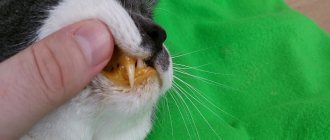Hearing organ in cats
In cats, the organ of hearing is the ear, and, like in most chordates, it is also responsible for the position of the body in space (balance).
The ear consists of the following sections:
• The outer ear is a sound-receiving organ consisting of the auricle, muscles and ear canal.
o The auricle is a mobile, funnel-shaped fold of skin covered with hair.
o The external auditory canal is a hollow tube made of elastic cartilage and a tube of petrous (temporal) bone that conducts sounds from the concha to the eardrum.
• The middle ear is a sound-conducting and sound-transforming organ with a tympanic cavity and bones in it.
o The tympanic cavity is a cavity in the tympanic part of the temporal bone. It has two windows - the window of the vestibule, closed by a stapes, and the window of the cochlea, closed by a membrane. On the front wall there is a hole that opens into the Eustachian (auditory) tube.
o The eardrum is a weakly extensible membrane (0.1 mm thick) that separates the middle ear from the outer ear.
o The auditory ossicles are a chain of special ossicles of the malleus, incus, lentiform bone and stapes, which at one end rests on the window of the vestibule, and the other on the eardrum.
• Eustachian tube - a canal connecting the middle ear cavity with the pharynx, ensuring equalization of pressure in the middle ear relative to atmospheric pressure.
• The inner ear is a spiral-shaped section of the vestibulocochlear organ, consisting of a membranous labyrinth embedded in a bony labyrinth.
o The bony labyrinth is a system of cavities in the temporal bone (vestibule, three semicircular canals and cochlea).
o The membranous labyrinth is a system of communicating cavities filled with special fluids, the walls of which are formed by membranes (semicircular canals, membranous cochlea, oval and round sacs).
The membranous cochlea is a spiral-shaped hollow organ filled with fluid (peri- and endolymph) that perceives and transforms sound vibrations.
The organ of Corti is an organ located on the surface of the cochlear membrane facing the cavity, covered with fiber cells (ciliated cells).
Features of congenital deafness
Often congenital deafness in cats is inherited and caused by a genetic failure. White, blue-eyed cats are often born deaf - this is a genetic feature. If you get such an animal, then you should check its hearing first.
Other causes of congenital deafness in kittens are a viral infection in the mother, or exposure to toxic substances on her body during this period. Typically, such deafness manifests itself as degenerative changes in the first week of a kitten’s life.
It is incorrect to diagnose “deafness” in a baby under 3-4 weeks of age. You cannot talk about the presence of pathology only on the basis of an animal’s behavior. Final conclusions are made when the kitten is taken away from its mother and brothers and sisters. Then he will not be able to copy the behavior of members of the “pack” and it will be possible to determine whether predictable reactions to sound have been formed.
Congenital deafness, caused by genetics, cannot be corrected. There is no way to cure a deaf cat. You can only learn to communicate with her and take into account the characteristics of such animals when keeping them at home.
Hearing Features of Cats
Cats hunt primarily by ear, a sense that is especially important for detecting mice. Therefore, a cat's ear is controlled by 32 muscles and can rotate 180 degrees. Cats detect sound waves in the range from 45 to 65,000 Hz, and distinguish sounds in a range of 10 octaves, with a difference of 0.1 tones. Cats detect ultrasound and hear best at a frequency of 8000 Hz.
They can also clearly distinguish between two different sound sources next to each other. It only takes 6 milliseconds for a cat to determine with centimeter accuracy where the sound source is located (at a distance of up to 3 m). In general, a cat can hear a mouse at a distance of 25 meters.
Cat hearing
This article will tell you how a cat’s hearing works, what a cat hears, as well as the peculiarities of sound perception. 04 September 2012
All cats have excellent hearing. Nature has endowed them with amazing abilities: cat ears can filter out from all surrounding noises exactly those that the cat itself considers the most important. Cats are sensitive to sound volume: three times more than humans.
Listening, the cat closes its eyes and slowly turns its head towards the sound. At this moment, it becomes like a radar, the ears straighten and twitch a little, as if taking the direction of the sound. The cat is able to hear the steps of the owner as soon as he approaches the door, and the noise of his car can be distinguished even during sleep. A cat can hear a mouse at a distance of 25 m, as it is able to detect the quiet sounds emitted by rodents in ultrasound. In the cat's hearing organ, in addition to the outer, middle and inner sections of the ear, there is a central section located in the brain. The outer ear is a shell (visible to everyone), a fold of skin that has a triangular or other (depending on the breed) shape, which is controlled by dozens of muscles. Thanks to this, it can change position: press, bend and turn relative to the head. At the base of the shell is the auditory canal - a small opening leading into a narrow canal ending in a dead end - the eardrum. There are many blood vessels in the auricle. The surface of the shell is covered with sparse hairs on the inside and dense hairs on the outside. The shells can rotate and move independently of each other. The direct purpose of the shell is as a sound-collecting funnel, which amplifies sounds that are weak for the cat - sounds emitted by mice, other cats, etc. Tuning a cat to sounds that are vital for it is the basis for the functioning of its hearing organ. There are weak sounds and there are sounds that are important for the cat, which she must sort out among other sharp similar sounds - these are the voices of the owners, their own kittens, the voices of other cats, dogs. These sounds are interspersed with other similar sounds, such as household sounds. The task of recognizing certain sounds is solved mainly by the central section, but the outer ear plays an important role due to the possibility of resonance of the air cavity of the external concha. The outer ear also performs an acoustic task - localizing sound, determining its location. For this purpose, the hearing organ simultaneously uses both shells. The brain, thanks to their autonomy, receives information about the differences in a single sound on the right and left. These differences arise (sound shadow effect) because the sound arriving at the nearest ear is less attenuated, since its arrival time will be shorter. Both ears will also distinguish other characteristics, by comparing which the cat accurately determines the location of the sounding object and will be able to take certain actions in time. A cat's middle ear is also tuned to detect vital sounds. It is a middle ear cavity with three auditory ossicles and two muscles. From the eardrum, sound vibrations are transmitted to the auditory ossicles, and the “stirrup” rests on the membrane of the oval window, from which the inner part of the ear begins. Vibrations from one membrane through the bones are transmitted to another, where changing parameters regulate sound transmission, thereby weakening and even blocking too harsh sounds. Without this, the receptor cells located in the inner part of the ear would not be able to work. Their main task is primarily to correctly perceive very faint sounds within a certain range, which are vital for the cat. The perceiving cells, like any delicate instrument, were carefully protected by wise nature from unnecessary overloads. They are in a liquid protected by membranous tissue on top and bottom in a bone case twisted in the shape of a spiral. This is where the inner ear got its second name – cochlea. The place where the sensory cells are located, as well as all the supporting structures of the inner ear, is called the “Organ of Corti.” Below the receptive cells are the endings of the auditory nerve. Receiving information about sound, which has been previously processed by the perceptive cells, numerous nerve endings transmit it to the fibers of the auditory nerve. A cat has 1.7 times more such fibers than a human. Auditory information, passing through the medulla oblongata, midbrain and intermediate brain regions, reaches the auditory cortex of both hemispheres of the brain. Sounds, passing this way, can be comprehensively and completely analyzed by the brain, which issues the necessary commands to the motor centers. In a certain situation, a cat acts expediently: it runs away, approaches or purrs. The cat's hearing range allows it to hear sounds from the ultrasonic region, reaching, according to some sources, from 65 to 100 kHz. The cat hears the sounds of small rodents and their babies. In addition, she can catch a running mouse, focusing only on squeaks and rustles. The human ear is not able to determine the location of sound with such accuracy. Cats are able to detect sounds by transmitting them to brain receptors through their paws. This ability of cats is called “seismic hearing.” The cat is able to perceive the slightest vibrations of branches or soil, which allows it to anticipate the weather in advance.
- Like
- COMMENTS
- |
- leave a comment
- |
- Add to favorites 0
How to tell if your cat can't hear
It is not easy to notice absolute deafness in a cat - it compensates for the lack of hearing with its available senses. You need to be careful when looking at your pet's behavior. There are several signs that an animal is deaf.
Listen to the cat's meow. Deaf animals cannot hear themselves and scream in a higher voice.
The simplest test is to track your pet’s reaction to sound stimuli. If the cat does not hear, then it will not react at all.
What sounds can be played:
- clap your hands loudly;
- turn on a vacuum cleaner, hair dryer or any other loud household appliance;
- knock on the door;
- rustle with the bag or foil.
An obvious sign of deafness in a cat is that it does not respond not only to the nickname, but also to “kitty-kitty-kitty”, and generally does not respond to the owner’s voice.
What else will indicate deafness:
- the cat doesn't greet you at the door;
- flinches when they wake her up, does not notice how they entered the room;
- the cat has an unsteady gait;
- the ability to orientate in space has deteriorated.
If in doubt, a veterinarian will help you make a final decision. You can show him both a kitten and an adult. Specialists have many methods and tests in their arsenal that help officially diagnose an animal’s deafness. In particular, veterinarians test hearing by monitoring the brain's reactions - whether there is a reaction to a clicking sound directed into the cat's ear or not. The hearing of infants is checked in the same way.
If deafness is not congenital, but acquired, then the doctor will draw up a treatment regimen. In case of congenital deafness, all that remains is to follow the practical advice on keeping an animal without hearing.
Proper handling of a deaf cat
Deaf cats usually behave like their hearing cats and do not feel inferior. If the animal does not sense danger, then it behaves friendly and devotedly. The task of the owner of a special cat is to ensure its complete safety and learn to communicate.
A deaf cat cannot hear, but at the same time perfectly detects vibrations and vibrations. However, keep in mind that your silent appearance in the room will frighten the animal. A similar reaction will be caused by sharp vibrations of sounds. Because to prevent the cat from being scared by your approach, start stomping harder from afar. Do not approach her from behind - try to get into the pet’s field of vision before approaching. Behave the same way if you intend to stroke it. The cat must see the hand approaching it and only then feel the touch.
If an animal is constantly “attacked” unexpectedly, it will become aggressive and begin to fight back.
When interacting with a deaf animal, attract its attention by loud clapping or knocking on the floor. The cat will pick up the vibrations and understand where they are coming from. If in this case the pet ignores you, this is a conscious choice. Inventive owners of deaf cats attract the pet's attention with light signals, for example, turning on a small flashlight.











